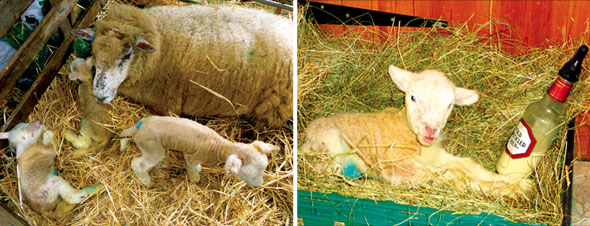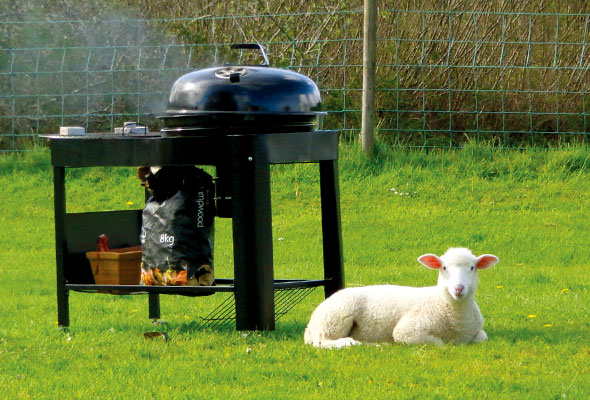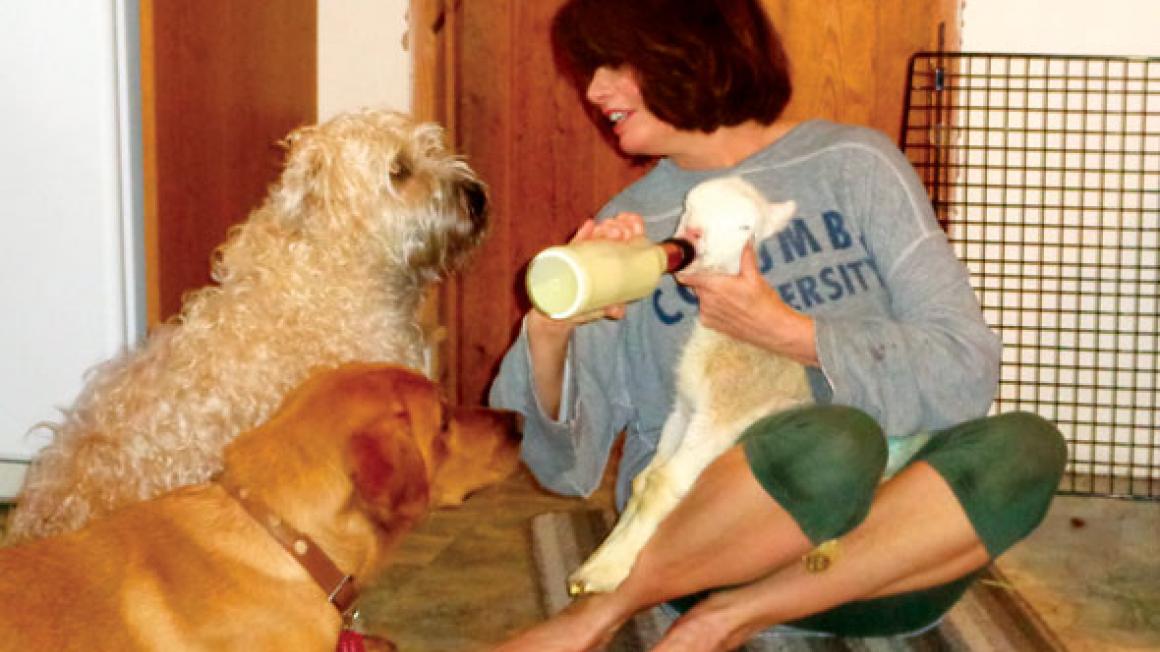EWE CANNOT BE SERIOUS
Ugh. It was time for another feed. I nudged my husband, Chris.
‘Honey?’
Nothing. I tried again, this time more of a shove than a nudge.
‘Chris? Can you go down and feed her, please?’
Still nothing. Damn that selective male hearing. I knew he was faking. And he knew I couldn’t ignore her cries.
Zombie-like, I grabbed my robe and staggered downstairs.
‘Hold on, sweetie pie, I’m coming…’
 Left: Brianne’s first tame lamb, Casserole, and her triplets. Right: Pie was fed from an Old Speckled Hen ale bottle
Left: Brianne’s first tame lamb, Casserole, and her triplets. Right: Pie was fed from an Old Speckled Hen ale bottleThis is an all too familiar scenario for millions of sleep-deprived parents. Thing is, I’m not a mum. Chris and I don’t have any children – we have lambs. While most of the UK watches Lambing Live on the BBC, I’ve been living it.
But I’m not a farmer. I’m a New Yorker. Before moving here, the closest I ever got to fresh lamb was at my butcher’s counter on the Upper West Side of Manhattan.
Nonetheless, there I was, in the wee hours of the morning, on my knees in my kitchen, feeding fourday- old Pie from an Old Speckled Hen ale bottle.
On our small Devon farm we have lots of ewes and a very randy ram, affectionately called Rambo. Rambo ‘served’ 17 of the ewes in October and now that spring has sprung (at least a bit), lambs have begun to pop out as quickly as our daffodils.

Pie was one of triplets, born from my very first tame lamb, Casserole. Casserole had a difficult time with this birth and could only feed two of her brood. The tiniest had to be brought inside and placed in the warming hatch of the Stanley stove.
On that first night, Chris fed Pie colostrum replacement through a tiny tube, which he expertly slid down her throat. If we were lucky, this would give her the strength to make it through the first crucial hours. All we could do was watch, wait and keep her warm. We being me and our dogs, Crumble and Tipper. Chris had gone to bed.
So far, Pie is doing well. It’s just us suffering from the sleep deprivation.
This year, a typical lambing day involves me, the reluctant midwife, keeping an eye on our ever-expanding ewes, while Chris goes to work. This means checking on them about every three hours. It’s tough work.
I certainly didn’t get into this as an expert. To paraphrase Butterfly McQueen in Gone With The Wind, ‘I don’t know nothing’ ’bout birthin’ no… lambies!’
 Best of friends: Pie with Crumble and Tipper
Best of friends: Pie with Crumble and TipperChris had shrugged off my initial hesitations when I’d first moved onto the farm with him a couple of years ago, and given me a quick lambing primer instead. I was to look for signs such as the ewes pawing the ground to make a nest, while checking each posterior to see if there was a stringy thing coming from their bottoms.
Really? Was he kidding me? I reminded him that I was from New York. He paid no attention and continued. If a lamb got stuck, I was to reach in and pull a leg out, one at a time. This should make room for the head to slip out smoothly. If the head was stuck, I was to reach in further, and gently ease it out, all the while praying that the ewe was still pushing. The rest of the body should follow. If it wasn’t breathing, I was to pinch its toes and swing it around by its legs to clear out the lungs.
Excuse me? Was he out of his mind? I was in way over my citified head. He insisted that I had what it takes, stressing that most lambs are born with no complications. And if the worst should happen, he said, he was only a 10-minute drive away.
This year, every few hours, I have been trekking nearly a mile from our house to the birthing shed, which I now call the OC – Oestrogen Central. And for a while, all was calm.
But then the ewes seemed to stop baa, baa, baa-ing. Instead, I swear I could hear them crying out: ‘Ep-epepi- durrral! Ep-ep-epi-durrral!!!’
These girls were so huge, it hurt to look at them. I gingerly tiptoed around looking for stringy things and goo in general. Happily, as the days passed, much to my delight and relief, I arrived to discover healthy newborns being beautifully cared for by their mums.
Even when the triplets were born, all was fine. The only issue was that poor exhausted Casserole didn’t have enough milk for three. I would now be feeding two lambs in the shed and the other, Pie, in the kitchen, while also keeping watch on the mothersto- be. This lambing thing was a bit hectic, but nothing I couldn’t handle… or so I thought.
One rainy morning, I noticed a stray lamb stumbling around behind a hay bale. At first, I thought it had escaped a stall but when I went to retrieve it, the protective mother stomped her hoof, warning me to stay away from her newborn.
That’s when I spied something in the corner. The new mother was only interested in her live lamb and no longer paying any attention to me, so I was able to move in for a closer look. It was an embryonic sac, with something white and pink inside.
Cautiously, I peeled it open. The lamb wiggled a bit, but it wasn’t breathing. I completely forgot about the toes and the swinging – and instead reverted to basic Girl Guide CPR. I cleared out its throat with my little finger to open an airway, turned it on its side and lightly began pressing on its minuscule chest. No response. Finally, with no time to lose or worry about germs, I took a deep breath and gently administered mouth-to-mouth. After a few soft breaths, the lamb coughed a bit and let out a cry. I gathered him up, tucked him under my coat and ran home to call Chris.
 Tempting fate? The barbecue holds no fears for Pie
Tempting fate? The barbecue holds no fears for PieChris was there in less than 10 minutes. We turned on the Stanley and placed the lamb in the warming hatch. He was too weak to try to feed. All we could do was warm him up and move his limbs each time he stopped breathing. He tried so hard to stay alive. Sadly, after 30 minutes, we lost him.
There have been two further stillbirths, but all in all it has been a joyful and successful lambing season: 35 lambs from 17 ewes. By the time the last two were born, Pie had begun to sleep through the night, her days spent playing in the garden with her best friends, Crumble and Tipper.
Pie has no idea she’s a lamb and there’s no doubt she believes I’m her mum. Soon it will be time for me to put her out with the rest of the lambs, including her brothers, and reintroduce her to her real mum, Casserole. It’s not easy being a mother when it’s time to let go. Buying some time, I told Chris we’d do it after Easter.
Ah, yes, Easter. Along with countless others, it is my Easter lunch tradition to serve roast leg of spring lamb. Medium rare, with a hint of garlic, sprinkled with fresh rosemary. In years gone by, the aromas wafting from my kitchen in New York would bring my neighbours over long before it was ready. We’d open a bottle of red and toast my roast while I whipped up some gravy. This year, however, I have reconsidered my choice for a main course. We have a rule here on our farm: ‘If we name ’em, we don’t eat ’em.’
None of our family will be on the menu. For me, the idea of eating any lamb this close to lambing is just not on, as you Brits say.
I have convinced Chris that we should start a new tradition… Easter ham. That is until we get our pig. I’m naming her Cracklin’.



